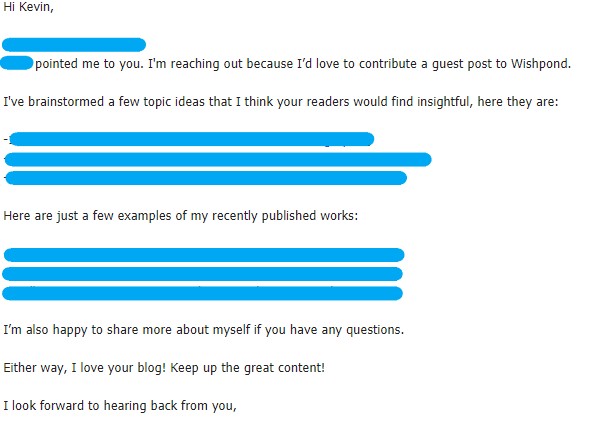Blogging is the heart of any content marketing strategy. Producing your own original content showcases your voice, your knowledge builds trust among your readers and positions you as more than a service provider: it gives your company a personality and your writers as experts.
Once you’ve mastered blogging, guest posting is the next natural step and will do wonders for building your site’s authority and your relationship with other outlets.
But like any other skill, it takes practice and a honed approach to secure the best guest posts.
Here, we’ve put together a master guide to guest posting. It includes:
- Why to devote time to guest posting
- How to craft the perfect pitch
- What to avoid in your pitches
- Guest post etiquette
Reasons to guest post
With packed to-do lists and more than can be done in a day for any marketing team as is, it can be difficult to mentally justify creating content for someone else’s site.
And make no mistake, guest posting undoubtedly takes extra effort. For especially high ranking blogs, finding a topic they’ll accept means combing through their archives, proposing a list of topics and then writing a piece that fits their guidelines.
You might be wondering if guest posting is worth it as part of your marketing strategy.
Short answer: yes.
Securing guest posts on other high quality sites that are in your industry can help raise your profile and boost your website’s rankings. It:
- Showcases your expertise
- Grows your social media following
- Exposes your work/product/services to a new audience
- Increases your website’s domain authority through backlinks (especially with websites with a higher DA)
- Strengthens your network with other outlets
Moreover, it carries all the benefits that blogging for your business does.
If you’re new to guest posting, as an independent freelancer or as a content writer, we’ve put together a guide for guest posting.
Good Cold Pitches
Before you can write your stellar guest post, the first step is getting it accepted. And that means getting in with the editors.
If you don’t have a personal connection, you’ll need to go the route of the cold pitch. If that sounds terrifying to you, don’t worry! Most guest posts go through cold-pitching.
A good cold pitch:
Shows You Know the Blog
You can make great time sending out the same generic email to everybody, but an editor will be able to tell if you have.
Marketing blogs each have specific niches, voices, specializations and personalities.
The editors reading your blogs are likely the same ones who spend hours poring over the subject lines, SEO and images you see on the websites you’re aiming to get your words on. They’ll be able to tell if you’ve seen their work.
While you don’t have to go as far as naming your top 3 favorite posts and listing why, you should at least demonstrate that you’re familiar with the topics each site prefers to talk about, or their target audience.
Shows Your Expertise
With droves of writers sending generic emails, editors want to know they’re assigning pieces to writers who know their topic.
State if you work for a company that works in the same industry; if you have relevant articles that you’ve written previously to show you can handle a similar assignment, send them along; if you have an original point you want to make, state it and back it up (preferably in a few sentences.)
States What You Can Offer
Can your company offer original research? Can you get on-the-ground insight that their writers might have difficulty accessing? Do you have a bunch of great ideas that are exactly what their target audience is interested in?
Let them know!
If you’re stuck for ideas on how to frame your knowledge in a catchy blog post, here’s an infographic on 12 brilliant ideas for blog posts.
Gets to the Point
This may seem like a lot but the final secret of a great cold pitch is saying all this…in as little time as possible.
To show you know their blog, you don’t need to do an in-depth literary critique: personalize your email (if possible) and offer blog topics that are fresh, relevant and that they haven’t covered.
To show your expertise, you don’t need to attach your resume: a few links or stating your experience in the industry may be social proof enough.
A cold pitch we loved:

Not-So-Great Cold Pitches
Just as there are great cold pitches, there are also terrible ones.
Are Generic (Or Wrongly Addressed)
Greetings matter!
If you’re sending a pitch to a person, double check you’ve spelled their name right. First names are often permissible in the blogosphere, but don’t use nicknames. (E.g. if their name is ‘Daniel’, don’t use ‘Dan’.)
If you have to send a pitch to a generic address, “Hi Company Name” is okay at a push, but if you’re going to go with a generic greeting, ensure the rest of your email demonstrates you’re familiar with the specific blog.
Make Editors Doubt Your Authenticity
Generic statements about being an avid reader of the blog (without ever mentioning a person’s name, or the blog itself), are a bright red flag for editors.
If you don’t have previously published clips, don’t claim to. It’s much better to say you’re trying to build up your portfolio and send a sample article or offer to write a draft for their consideration than to bluff that you’ve written before. (Remember: a quick google will tell any curious editor everything they need to know.)
Make Editors Doubt Your Ability to Deliver
For a very busy editor, even small mistakes can be your pitch’s direct ticket to the ‘deleted items’ folder.
If your pitch is riddled with typos or grammar mistakes, your editor is going to assume your piece will be too.
If the email is addressed to someone from a different company, they’ll delete it before they hit the second line.
Proofread, proofread, proofread.
Guest Post Etiquette
Like any good guest, there’s good manners. Editors don’t only remembers the quality of your writing, they remember how much they liked working with you.
If you want to make a really stellar impression, here’s a few pointers on the less editorial elements of guest posting.
Wait — minimum — a week to follow up (but expect it to take much more time than that at major marketing blogs). It’s frustrating when you’re ramped up and excited to see a byline come out,, but the timeline for blogs can be short or very long.
Editorial calendars are subject to a number of factors, and often outside of the editor’s control: don’t harangue editors to get your post up or to get you a sooner date. We’ve waited for up to 6 months to have a blog published.
Edits are a part of the game. If you’ve sent in a post you think is perfect, it might be hard to see a published version appear with entirely new sentences or words in it, but that’s to be expected!
Each marketing blog has their own preferences and their own distinct reasons for their style choices, and it’s very rare that the draft that’s sent in will be the final version that appears on site.
If it’s overly promotional, expect it to be axed. Most places will have guidelines stating how many promotional links they’ll allow you, but if they don’t, be careful not to make your piece too promotional.
The emphasis on guest posting is on the word ‘guest’, and like any guest, your focus should be on being considerate. Provide value for the site’s readers, fit into their guidelines, and don’t name-drop. Use links to your site sparingly or only when they serve to really prove a point.
The blog should promote your piece, but it helps if you promote it too for maximum leverage. If you want to be a repeat writer for a blog, help funnel views to their site by sharing on your social channels.
Grab Your Downloadable Guest Posting Guide
Click here to download your FREE Guest Posting
Resource Packet. All the things you need to get started, with resources like templates for cold pitches and more!

